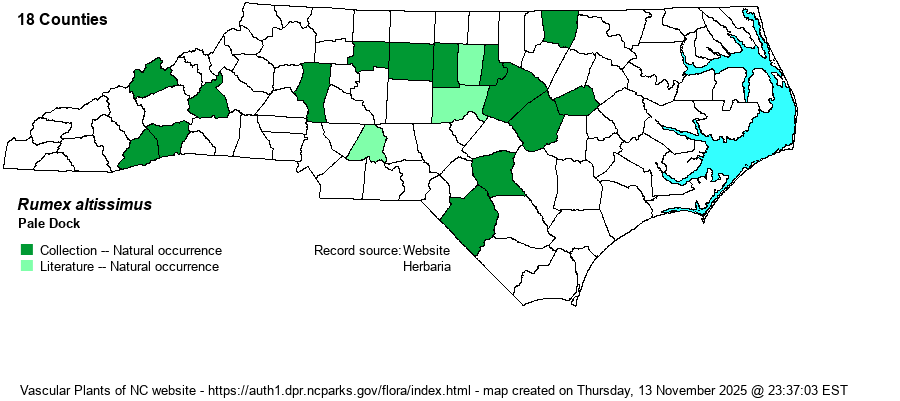| Author | A. Wood | |
| Distribution | Widely scattered in the Mountains, Piedmont, and inner Coastal Plain.
ME to MN, south to GA, TX, AZ; northern Mex. | |
| Abundance | Seemingly rare or uncommon, but certainly passed over as R. verticillatus, and rarely collected in the past few decades (apathy?). The NCNHP lists this as a Watch List species, and the "?" after S2 is definitely deserved, as its current abundance can only be inferred by the spread of the collections on the map. | |
| Habitat | Creeksides, low pastures, damp fields, wet roadsides, railroad margins. Typically in wetlands, but mostly found in disturbed places. | |
| Phenology | Flowering and fruiting March-July. | |
| Identification | Pale Dock typically grows 2-3 feet tall, with lance-shaped leaves to 4-5 inches long. The terminal inflorescence is composed of densely packed flowers, to less densely packed and with space between nodes; the winged fruits are yellow green to light green. From the very similar Swamp Dock (R. verticillatus) it differs mainly by shorter flower stems (3-8 mm vs. 10-15 mm), such that the fruits in Pale Dock look almost sessile (and non-drooping) in the inflorescence. In the commoner species, the pedicels are much longer than the fruits, such that the fruits tend to dangle or droop in the inflorescence -- easily noted much of the season. This species should not be as scarce as it seems to be, considering that it grows in open wetlands, often where disturbed. The fact that nearly all collections are rather old is troubling, though there seems little reason to think a plant of disturbed wet or damp ground would be strongly declining. | |
| Taxonomic Comments | None
| |
| Other Common Name(s) | Tall Dock | |
| State Rank | S2? | |
| Global Rank | G5 | |
| State Status | W7 | |
| US Status | | |
| USACE-agcp | FACW link |
| USACE-emp | FACW link |

